If more tennis players find themselves breathing easier, it might just be thanks to Carlos Alcaraz.
The four-time Grand Slam champion, whose bid for a second consecutive French Open title was scheduled to continue with a third-round match last night, has often worn a nasal strip in matches since last season — although not during his first two contests at Roland-Garros this week — and the sport’s other athletes took note.
After all, if Alcaraz finds something useful on the court, their thinking goes, maybe it makes sense to give the adhesive bands a shot.
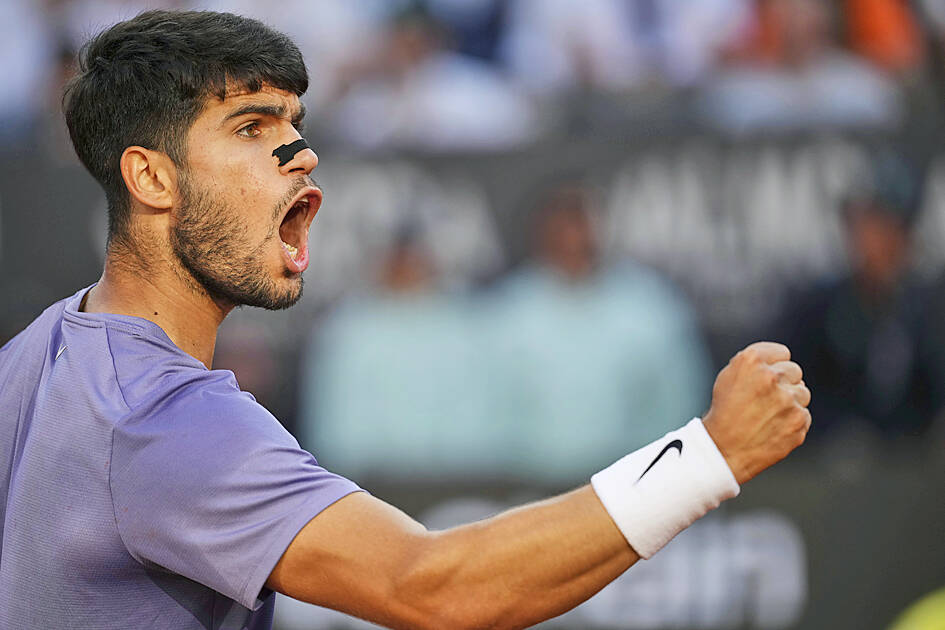
Photo: AP
“I saw Carlos playing in it,” said 18-year-old Mirra Andreeva, a semi-finalist in Paris last year and the No. 6 women’s seed this time. “I’d be pretty interested to try and see if there is really a difference. If he plays matches in it, then probably there is.”
At the season-ending ATP Finals in November last year, Alcaraz said: “It is something that I’m going to wear more often. I could recover better between points.”
Once associated with football Hall of Famer Jerry Rice and soccer stars such as Cristiano Ronaldo and Neymar, the bands, which essentially look like a Band-Aid worn across the bridge of the nose, are popping up on tennis courts — sometimes out of necessity, sometimes out of curiosity.

Photo: EPA-EFE
They are designed to open the nostrils slightly, making it easier to breathe through the nose. Originally marketed to reduce snoring, they are being embraced to enhance air intake during physical exertion.
The idea is simple: Better breathing could mean better oxygen intake.
In practice, the science is less convincing.

Photo: AFP
In 2021, Brazilian academic Ricardo Dinardi reviewed more than 600 studies on nasal strips and found that they did not make a real difference in how much air athletes took in, their heart rate or how strenuous exercise felt.
“The effect on athletic performance is mostly placebo, but in elite sports, even perceived benefits can count,” Dinardi said.
Three-time major finalist Casper Ruud, who wore the strips in matches earlier this year, knows the evidence is shaky, but he still liked using them — on the court and while sleeping. Like Alcaraz, Ruud did not wear one in Paris before his second-round exit.
However, he has been testing a prototype of a different version.
“I tried out a device that’s very early in development. It will be a bit more comfortable to wear, because it’s inside the nose and it looks like I have this bullring under,” said Ruud, who was the runner-up at Roland-Garros to Rafael Nadal in 2022 and Novak Djokovic in 2023. “It will return, don’t worry.”
For other players, like Nicolas Jarry, the strips are more than a trend — they are a necessity. After nasal surgery in 2020, the Chilean still needed help to draw air into his nose, so he puts them on for every practice and every match he plays.
“Without it, I cannot breathe. My nostrils shut when I try,” he said, inhaling to demonstrate for a reporter. “Others don’t have that issue and still use them.”
There are those, like last year’s US Open runner-up Jessica Pegula, who are tempted to try.
“I have a horrible deviated septum. I can’t really breathe out of one side of my nose,” said Pegula, who is to play 2023 Wimbledon champion Marketa Vondrousova in the third round today. “Maybe I should start wearing one.”
However, the aesthetic aspect might be a deal-breaker, she added.
“I don’t know if I have the confidence to rock one,” she said with a smile.
On the courts, Taiwan’s hopes in the women’s singles ended with the defeat of Joanna Garland on Thursday.
Kazakhstan’s Yulia Putintseva beat the 24-year-old, England-born Garland 7-6 (7/5), 6-3 in the second round at Stade Roland Garros.
The Kaohsiung-raised player on Tuesday became the first Taiwanese to clinch a victory in a main singles draw of the French Open since 2020 after she outlasted the US’ Katie Volynets.
The world No. 175 is Taiwan’s highest-ranked female player in singles.
In the women’s doubles, Taiwan’s Hsieh Su-wei and Jelena Ostapenko of Latvia eliminated Greet Minnen of Belgium and Hungary’s Anna Bondar 6-3, 3-6, 7-6 (7/3).
Their win set up a second-round clash against the Czech Republic’s Anna Siskova and Kamilla Rakhimova of Russia.
Additional reporting by staff writer
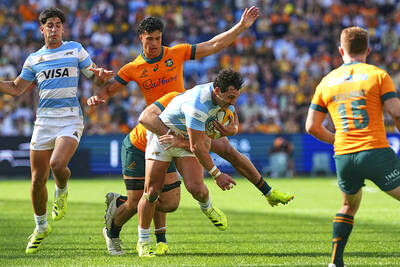
‘DEVASTATED’: Argentina’s win was a reversal of their 28-24 defeat last week, with Australian forward Fraser McReight adding that ‘we did the same thing last week’ Argentina flyhalf Santiago Carreras punished an undisciplined Australia with 23 points off the tee as the Pumas held on grimly for a 28-26 win in Sydney yesterday to breathe new life into their Rugby Championship campaign. A try-fest beckoned in afternoon sunshine at Sydney Football Stadium, but Argentina needed only one through captain Julian Montoya, with Carreras doing the damage with seven penalties and a conversion in front of a sell-out crowd. A week after letting a 14-point lead slip in a 28-24 defeat to Australia in Townsville, Argentina saw most of a 21-point advantage erased in the final quarter as the
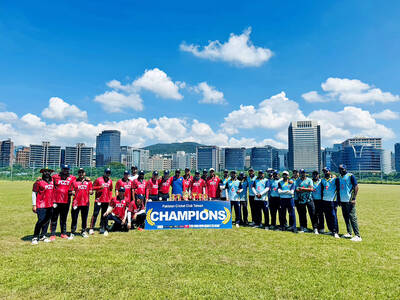
Captain Vijay Kumar led the way yesterday as the Hsinchu Titans claimed the Taiwan Premier League title at the Yingfeng Cricket Ground in Taipei’s Songshan District (松山), beating PCCT by 27 runs. The weather was a topic again, but not the rain that played a role in previous matches in the often-delayed tournament. Kumar, who made 80 not out from 63 deliveries, and teammate Vishwajit Kumar (58 from 43) rescued the Titans from a precarious state at the end of the power play in the T20 match. The visitors were put in to bat and struggled to 26-3 as PCCT
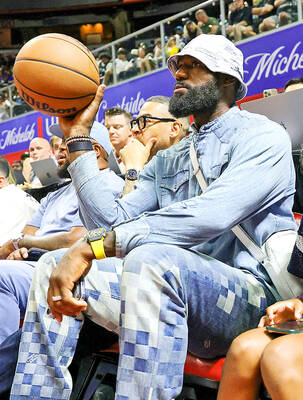
China’s state-run People’s Daily newspaper on Monday published an essay about Chinese basketball it said was written by LeBron James, but a representative for the NBA star said on Thursday that the article was based on a series of interviews. The paper, better known as the mouthpiece of the Chinese Communist Party, had said James authored the essay, “Basketball is a Bridge that Connects Us,” a tribute to Chinese players and fans of the sport written in the first person. “LeBron James Pens an Article in the People’s Daily,” read a post published on the newspaper’s official WeChat account. On Thursday, a representative
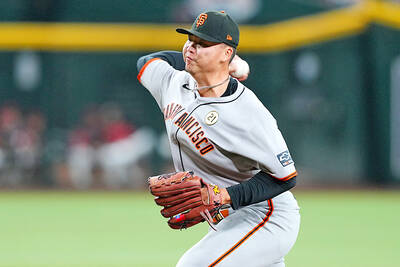
San Francisco Giants pitcher Teng Kai-wei impressed against the Arizona Diamondbacks on Monday despite an 8-1 loss in the opener of the team’s nine-game road trip. Teng, the only Taiwanese pitcher active in MLB, struck out five while allowing two hits and one walk over four innings at Chase Field to finish with a no decision, as the teams were tied 1-1 when he finished his outing. He surrendered the lone run of his outing in the bottom of the first, which began with a walk, a hit-by-pitch and two strikeouts. Diamondbacks leadoff hitter Geraldo Perdomo advanced to third on